A guide to headstamps
I thought I would do a quick guide to cartridge headstamps. I know many of us are well aware of what all the stamps mean, but some people dont and I think it would be useful to those people not yet as obsessed as me !!! :D :D :D
I will only cover American, British and German small arms headstamps. Please add a reply if you are good at larger calibre or other countrys headstamps (e.g. Russia, Japan).
To start with, here are the main allied small arms cartridges lined up so you can see the difference in overall shape and size. Take particular note of the difference between a standard 30calibre American cartridge and the British 303. Also note the difference between the standard 30calibre and the M1 Carbine cartridge (this is not live by the way ! I remade it from two bits :D).
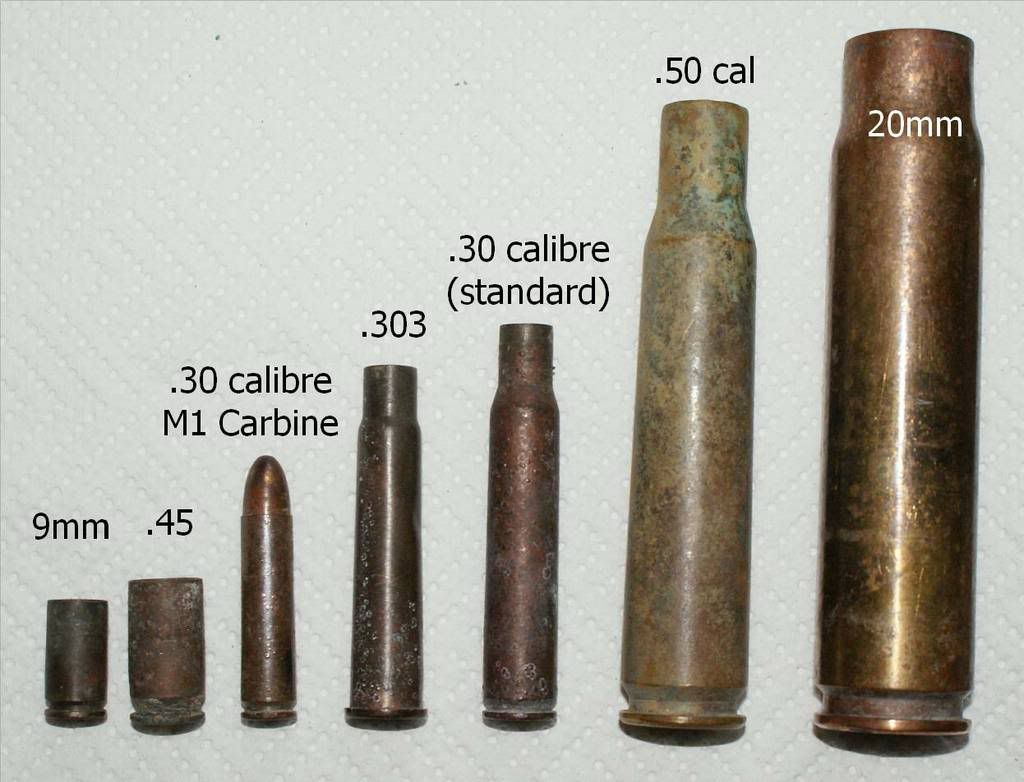
Ok, on to identifying Allied small arms headstamps.
Well start with 20mm cannon cartridges. A view of 3 cartridges found on various WW2 airbases.
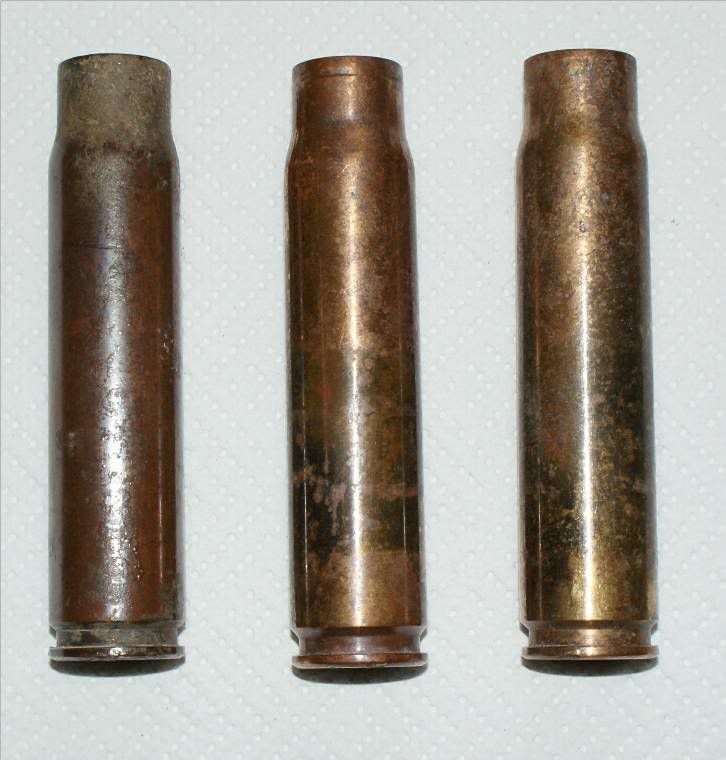
Ok. Lets look at the headstamps. You can see they all follow the same pattern. A letter code which represents the manufacturer, a date stamp and a calibre. The right hand case therefore is made by RG (Royal Ordnance Factory, Radway Green, UK), in 1942. The middle case was made by I.C.I. , otherwise known as Kynoch in Standish, UK which is represented by the K2, in 1944.
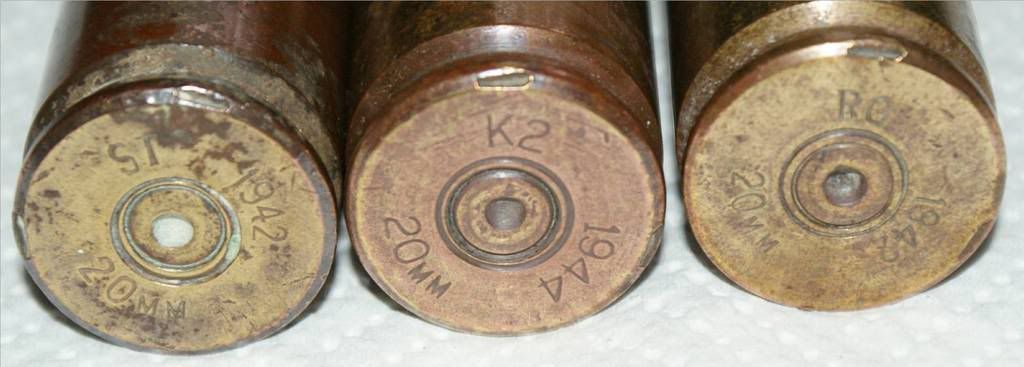
With American cartridges, the headstamps are usually very short, sharp and sweet ! Take for example these 50 calibre cartridges, again found on various airbases around the UK.
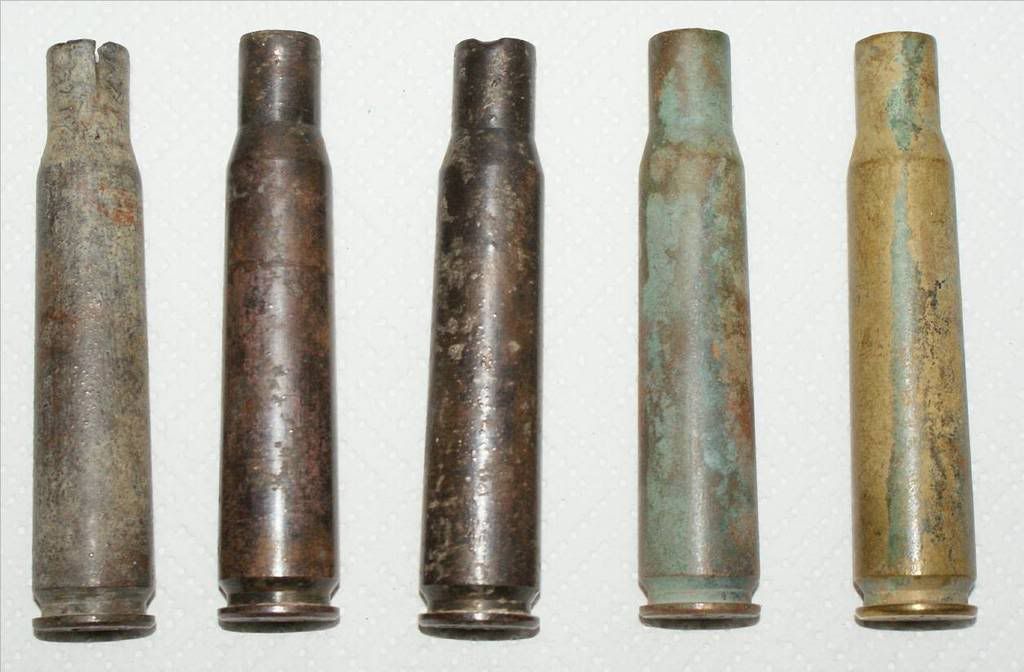
The headstamps on these are not as detailed as some. Usually you get the manufacturer code and the last two digits of the year, EXCEPT in the case of 1944 which is always represented by a single 4. So on these cartridges you have RA 43, TW 43, LC 43, SL 4 and DM 4. RA is Remington Arms Company, Tw is Twin Cities ordnance plant, LC is Lake City Ammunition Plant, SL is St Louis Ordnance Plant and DM is Des Moines Ordnance Plant.

These headstamps are repeated in standard 30 calibre and Carbine rounds. Take for example these 30 calibre cartridges, found on Slapton Sands.
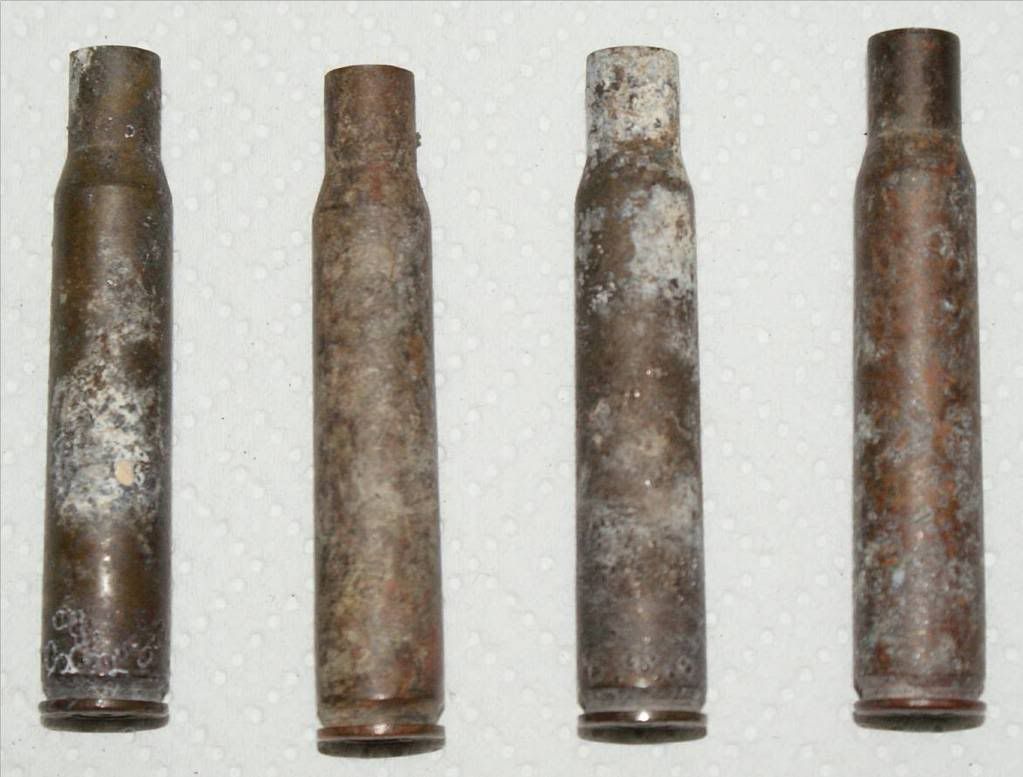
The headstamps all follow the same principals as the 50 cal cartridges.

British cartridges tended to be a little more verbose. Take for example these cartridges, all found on an old D-Day practice beach.
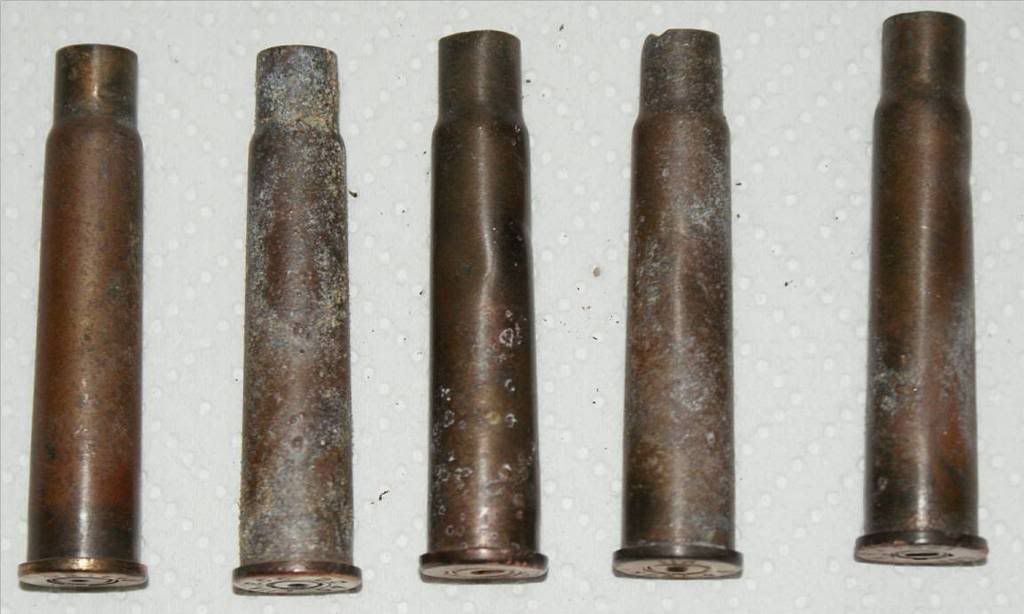
The headstamps, as you can see, contain a little more information. We still have the manufacturer code and the year of manufacture (as either 2 or 4 digit), but we also regularly see VII which denotes it is a standard ball round, and in some instances 303 which obviously denotes the calibre. It is interesting to note that the last three cartridges all have the same odd shaped firing pin mark. This elongated mark is made by the firing pin of a Bren gun. A Lee-Enfield makes the dot mark in the left hand two cartridges. So not only does the headstamp tell us something, even the firing pin mark can !
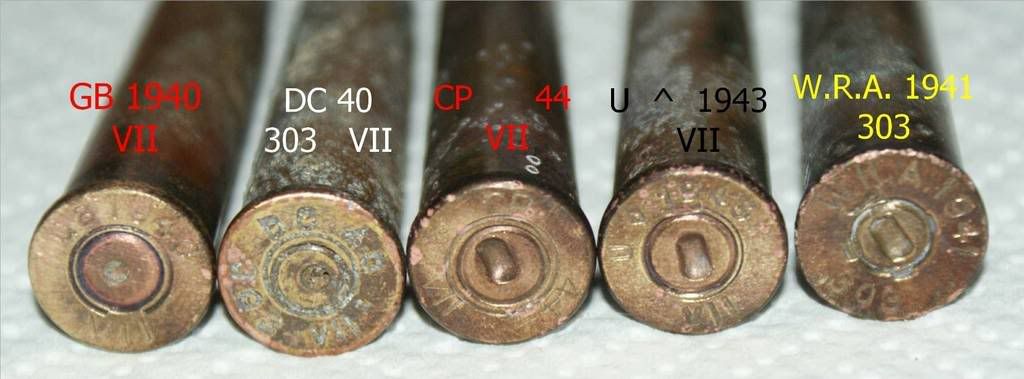
Now lets look at 9mm and .45 calibre cartridges, again found on a D-Day practice beach.
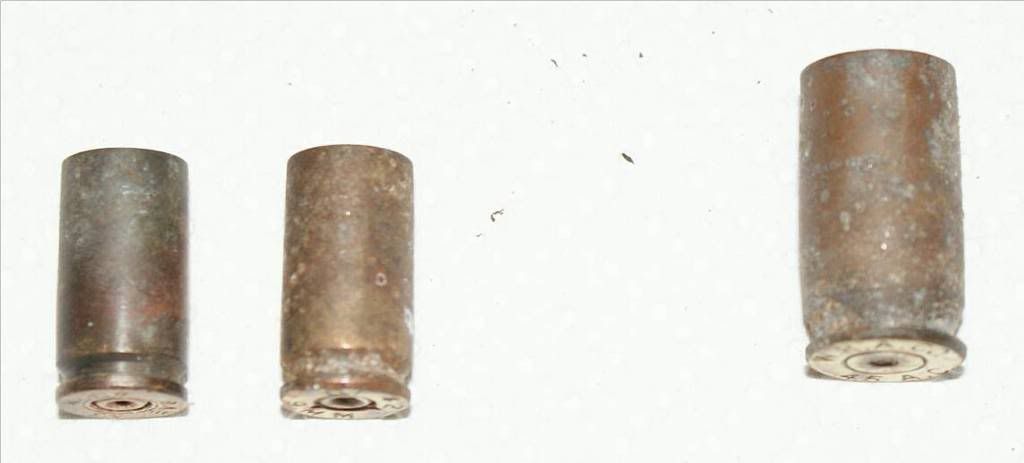
Now you can see a pattern emerging ! Hopefully you can now determine what the headstamps mean when you look at them. You have the manufacturer code, the year stamp and the calibre .Its easy once you know what youre looking at !
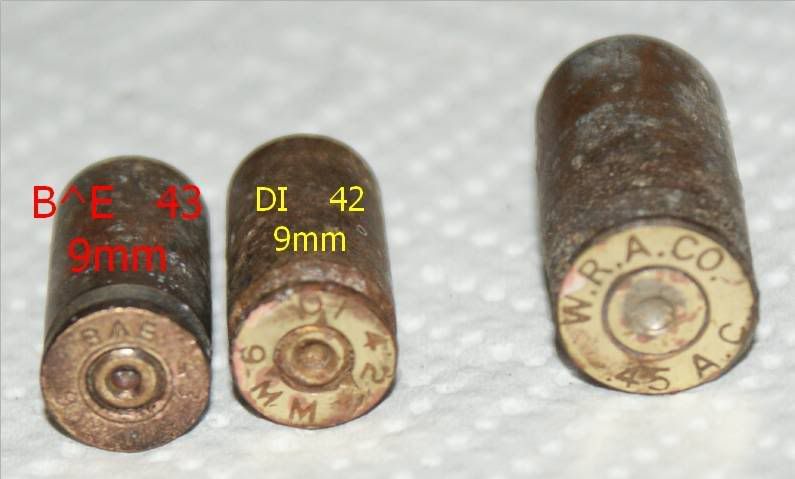
The Germans used a little more complicated system than the Americans and British. Take for example these 7.92 calibre cartridges, all are safe and were bought off a guy in an antiques place for 20p each ! He didnt know what they were but I did because of a basic knowledge of headstamps.
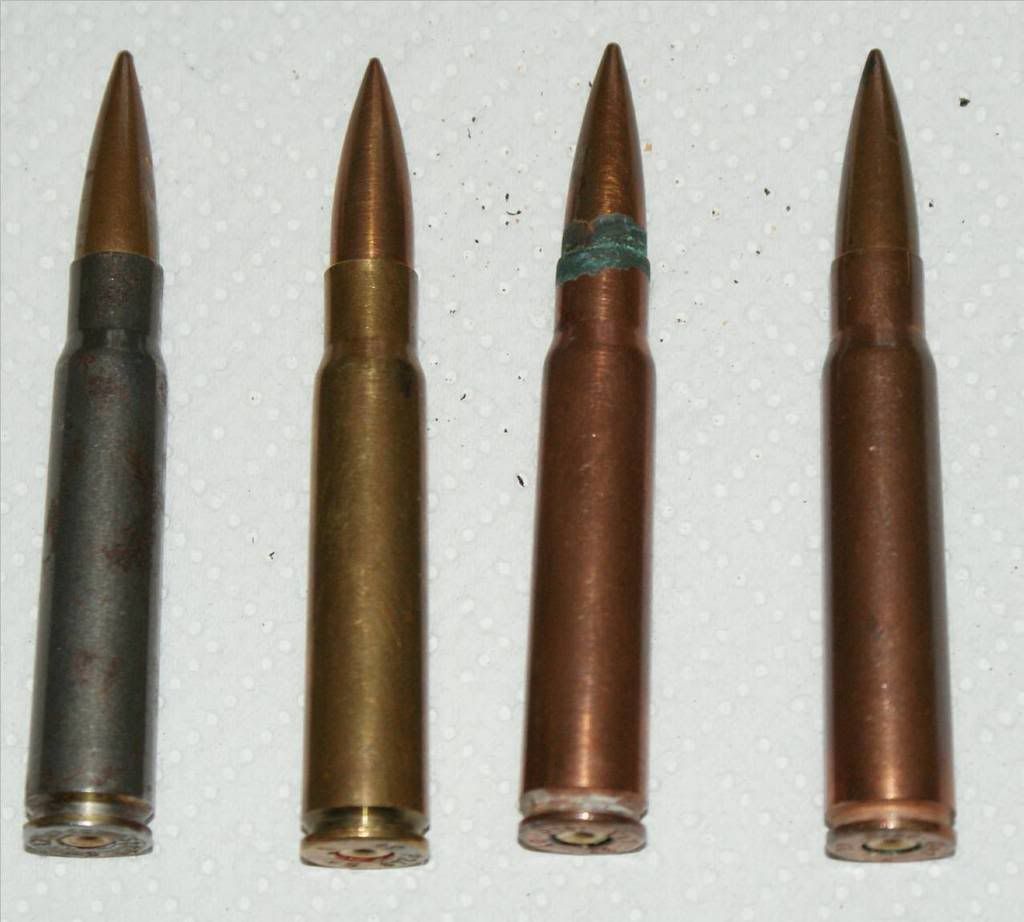
Ok ..all German 7.92 calibre cartridges carry four stamps. As you look at the picture, at 12 oclock is the manufacturers code. At 3 oclock is a code with a combination of a roman numeral (I to XXII) for the steel mill supplying the basic case-metal, a lower-case letter for the plating agency and an arabic numeral (1, 2, 3, 4, 6, 8, 9, 10, 11, 12, 15 or 17) for the steel-analysis, which all identifies a copper-plated steel case. In some cases you may see (as below) a code such as St or
St+ or S*. St or St+ indicates a steel case, either plated or lacquered. * or S* indicates a brass case. At 6 oclock is a batch number and at 9 oclock is the year of manufacture represented by the last 2 digits of the year. Of interest is the fact that the Germans changed their manufacturer code system. Between 1937 and 1941 they used the P codes (Patronenfabrik Nummer). Between 1940 and 1945 (there was some overlap between the change of coding) they switched to a letter code and ditched the P number. This means all P coded cartridges are made prior to 1941, and all letter code cartridges are made from 1940. This could be handy in identifying fakes !!!!
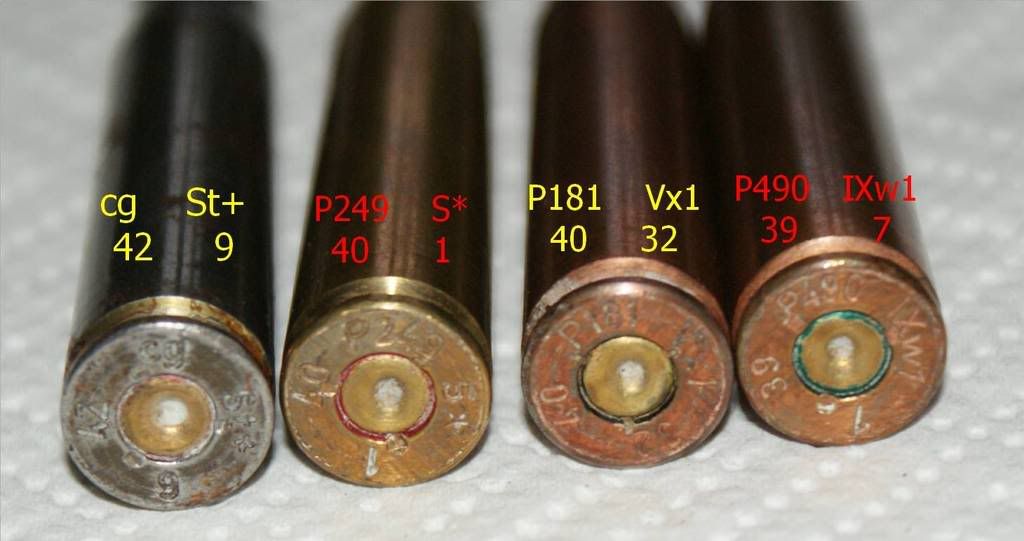
So, for example, the far left cartridge was made by cg (Finower Industrie GmbH, Finow/Mark, Brandenburg), the case was made of St+ (steel case, plated), a batch number of 6 (yes .i got it wrong on the picture !!! Its a 6 not a 9 :D :D ), and a year of 1942.
The far right hand case is made by P490 ( Hugo Schneider A.G., Werk Altenburg), the steel mill code IX (August-Thyssen-Hutte A.G., Duisburg-Hamborn), the plating firm code w, (Hugo Schneider A.G. Messingwerke, Taucha-Leipzig), and the steel composition 1. The batch number is 7 and it was made in 1939.
I hope this of use to some of you. I know many will already know it but its good to pass on this sort of information !
Here are some useful links.
German 7,92 headstamp markings 1937-1945 German headstamps
Headstamp Codes on Small Arms Ammunition General listing of small arms headstamps
.303 Headstamp Cartridge Identification 303 headstamp identification
IAA- Links to sites related to cartridge or ammunition collecting Links to a HUGE number of sites of interest to anyone who collects cartridges.
Have fun !!
Steve T
I will only cover American, British and German small arms headstamps. Please add a reply if you are good at larger calibre or other countrys headstamps (e.g. Russia, Japan).
To start with, here are the main allied small arms cartridges lined up so you can see the difference in overall shape and size. Take particular note of the difference between a standard 30calibre American cartridge and the British 303. Also note the difference between the standard 30calibre and the M1 Carbine cartridge (this is not live by the way ! I remade it from two bits :D).

Ok, on to identifying Allied small arms headstamps.
Well start with 20mm cannon cartridges. A view of 3 cartridges found on various WW2 airbases.

Ok. Lets look at the headstamps. You can see they all follow the same pattern. A letter code which represents the manufacturer, a date stamp and a calibre. The right hand case therefore is made by RG (Royal Ordnance Factory, Radway Green, UK), in 1942. The middle case was made by I.C.I. , otherwise known as Kynoch in Standish, UK which is represented by the K2, in 1944.

With American cartridges, the headstamps are usually very short, sharp and sweet ! Take for example these 50 calibre cartridges, again found on various airbases around the UK.

The headstamps on these are not as detailed as some. Usually you get the manufacturer code and the last two digits of the year, EXCEPT in the case of 1944 which is always represented by a single 4. So on these cartridges you have RA 43, TW 43, LC 43, SL 4 and DM 4. RA is Remington Arms Company, Tw is Twin Cities ordnance plant, LC is Lake City Ammunition Plant, SL is St Louis Ordnance Plant and DM is Des Moines Ordnance Plant.

These headstamps are repeated in standard 30 calibre and Carbine rounds. Take for example these 30 calibre cartridges, found on Slapton Sands.

The headstamps all follow the same principals as the 50 cal cartridges.

British cartridges tended to be a little more verbose. Take for example these cartridges, all found on an old D-Day practice beach.

The headstamps, as you can see, contain a little more information. We still have the manufacturer code and the year of manufacture (as either 2 or 4 digit), but we also regularly see VII which denotes it is a standard ball round, and in some instances 303 which obviously denotes the calibre. It is interesting to note that the last three cartridges all have the same odd shaped firing pin mark. This elongated mark is made by the firing pin of a Bren gun. A Lee-Enfield makes the dot mark in the left hand two cartridges. So not only does the headstamp tell us something, even the firing pin mark can !

Now lets look at 9mm and .45 calibre cartridges, again found on a D-Day practice beach.

Now you can see a pattern emerging ! Hopefully you can now determine what the headstamps mean when you look at them. You have the manufacturer code, the year stamp and the calibre .Its easy once you know what youre looking at !

The Germans used a little more complicated system than the Americans and British. Take for example these 7.92 calibre cartridges, all are safe and were bought off a guy in an antiques place for 20p each ! He didnt know what they were but I did because of a basic knowledge of headstamps.

Ok ..all German 7.92 calibre cartridges carry four stamps. As you look at the picture, at 12 oclock is the manufacturers code. At 3 oclock is a code with a combination of a roman numeral (I to XXII) for the steel mill supplying the basic case-metal, a lower-case letter for the plating agency and an arabic numeral (1, 2, 3, 4, 6, 8, 9, 10, 11, 12, 15 or 17) for the steel-analysis, which all identifies a copper-plated steel case. In some cases you may see (as below) a code such as St or
St+ or S*. St or St+ indicates a steel case, either plated or lacquered. * or S* indicates a brass case. At 6 oclock is a batch number and at 9 oclock is the year of manufacture represented by the last 2 digits of the year. Of interest is the fact that the Germans changed their manufacturer code system. Between 1937 and 1941 they used the P codes (Patronenfabrik Nummer). Between 1940 and 1945 (there was some overlap between the change of coding) they switched to a letter code and ditched the P number. This means all P coded cartridges are made prior to 1941, and all letter code cartridges are made from 1940. This could be handy in identifying fakes !!!!

So, for example, the far left cartridge was made by cg (Finower Industrie GmbH, Finow/Mark, Brandenburg), the case was made of St+ (steel case, plated), a batch number of 6 (yes .i got it wrong on the picture !!! Its a 6 not a 9 :D :D ), and a year of 1942.
The far right hand case is made by P490 ( Hugo Schneider A.G., Werk Altenburg), the steel mill code IX (August-Thyssen-Hutte A.G., Duisburg-Hamborn), the plating firm code w, (Hugo Schneider A.G. Messingwerke, Taucha-Leipzig), and the steel composition 1. The batch number is 7 and it was made in 1939.
I hope this of use to some of you. I know many will already know it but its good to pass on this sort of information !
Here are some useful links.
German 7,92 headstamp markings 1937-1945 German headstamps
Headstamp Codes on Small Arms Ammunition General listing of small arms headstamps
.303 Headstamp Cartridge Identification 303 headstamp identification
IAA- Links to sites related to cartridge or ammunition collecting Links to a HUGE number of sites of interest to anyone who collects cartridges.
Have fun !!
Steve T
